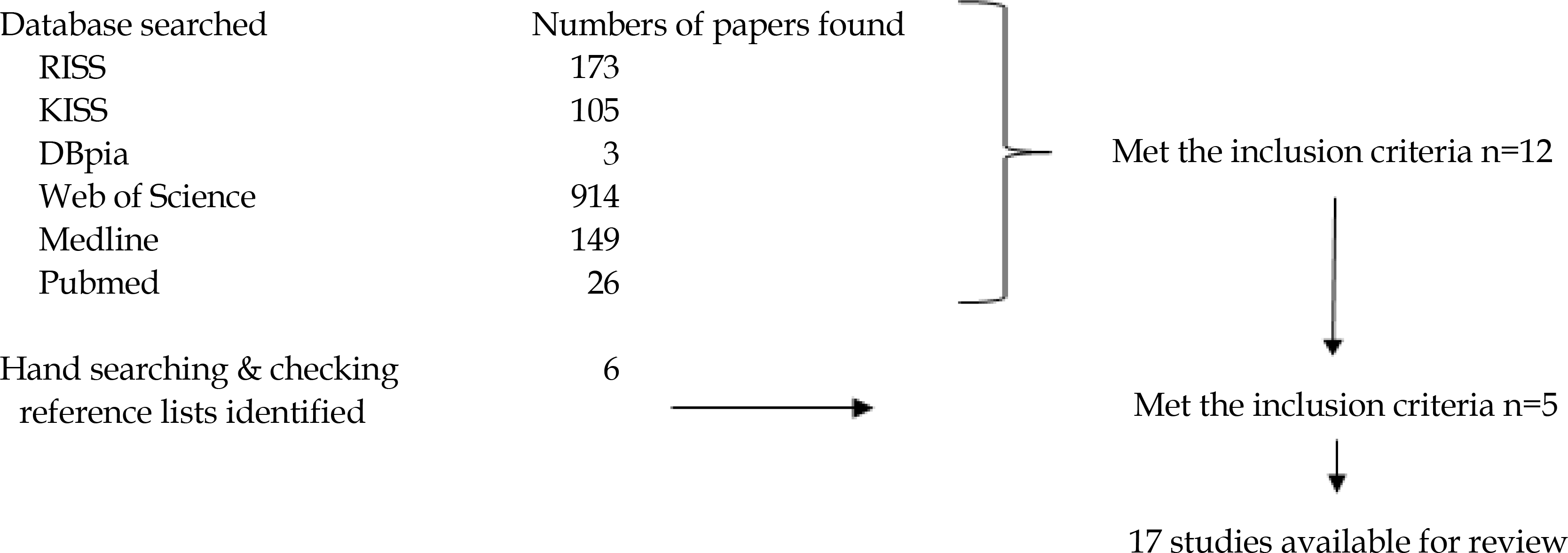Abstract
Purpose:
This paper is a review of interventions designed to promote self-awareness in the nursing area. The specific purpose was to analyze the general characteristics of self-awareness intervention studies, intervention contents, and the effects of the studies in order to present basic information for developing self-awareness interventions in the nursing area. Methods: Using “nurse/nursing” and “self-awareness” as key words, the researchers searched six electronic databases. The method proposed by Whittemore and Knafl was used. Results: Seventeen studies met the inclusion criteria. The most common research design was quasi-experimental. Nine quasi-experimental studies (52.9%), 7 qualitative studies (41.2%), and 1 mixed methodology study (5.9%) were analyzed. Most studies used group intervention and student nurses as participants. The interventions were revealed to be effective in enhancing participants’ self-awareness. The reflection method was used in most intervention approaches. Conclusion: To provide therapeutic nursing care, having self-awareness is important. Future research with well-designed clinical trials applying self-awareness intervention needs to be conducted to enhance self-awareness in the nursing area.
Go to : 
REFERENCES
1.Eckroth-Bucher M. Self-awareness: a review and analysis of a basic nursing concept. Adv Nurs Sci. 2010. 33(4):297–309. http://dx.doi.org/10.1097/ANS.0b013e3181fb2e4c.
2.Arnold EC., Boggs KU. Interpersonal relationships: professional communication skills for nurses. 7th ed.Missouri: Elsevier Health Sciences;2015. 155:p. 440–1.
3.Engin E., Cam O. Effect of self-awareness education on the self-efficacy and sociotropy-autonomy characteristics of nurses in a psychiatry clinic. Arch Psychiatr Nurs. 2009. 23(2):148–56. http://dx.doi.org/10.1016/j.apnu.2008.05.003.

4.Ahmed HAA., Elmasri YM. Effect of self awareness education on the self efficacy and sociotropy autonomy characteristics of nurses in a psychiatry clinic. Life Sci J. 2011. 8(2):853–63. http://dx.doi.org/10.7537/marslsj080211.111.
5.Demir S., Demir SG., Bulut H., Hisar F. Effect of mentoring program on ways of coping with stress and locus of control for nursing students. Asian Nurs Res. 2014. 8(4):254–60. http://dx.doi.org/10.1016/j.anr.2014.10.004.

6.Hasanpour-Dehkordi A., Solati K. The efficacy of three learning methods collaborative, context-based learning and traditional, on learning, attitude and behaviour of undergraduate nursing students: integrating theory and practice. J Clin Diagno Res. 2016. 10(4):VC01–VC4. http://dx.doi.org/10.7860/jcdr/2016/18091.7578.

7.Lestander O., Lehto N., Engstrom A. Nursing students' perceptions of learning after high fidelity simulation: effects of a three-step post-simulation reflection model. Nurse Educ Today. 2016. 40:219–24. http://dx.doi.org/10.1016/j.nedt.2016.03.011.

8.Scheick DM. Developing self-aware mindfulness to manage countertransference in the nurse-client relationship: an evaluation and developmental study. J Prof Nurs. 2011. 27(2):114–23. http://dx.doi.org/10.1016/j.profnurs.2010.10.005.

9.Unal S. Evaluating the effect of self-awareness and communication techniques on nurses' assertiveness and self-esteem. Contemp Nurse. 2012. 43(1):90–8. http://dx.doi.org/10.5172/conu.2012.43.1.90.
10.Wanda D., Fowler C., Wilson V. Using flash cards to engage Indonesian nursing students in reflection on their practice. Nurse Educ Today. 2016. 38:132–7. http://dx.doi.org/10.1016/j.nedt.2015.11.029.

11.Kim S. The effects of a self-awareness program using action methods for nursing students. J Korean Acad Soc Nurs Educ. 2006. 12(2):187–95.
12.Rasheed SP. Self-awareness as a therapeutic tool for nurse/cli-ent relationship. Int J Caring Sci. 2015. 8(1):211–6.
13.Vandemark LM. Awareness of self and expanding consciousness: using nursing theories to prepare nurse-therapists. Issues Ment Health Nurs. 2006. 27(6):605–15. http://dx.doi.org/10.1080/01612840600642885.

14.Cook SH. The self in self-awareness. J Adv Nurs. 1999. 29(6):1292–9. http://dx.doi.org/10.1046/j.1365-2648.1999.01014.x.

15.Delaney KR. Psychiatric mental health nurses: stigma issues we fail to see. Arch Psychiatr Nurs. 2012. 26(4):333–5. http://dx.doi.org/10.1016/j.apnu.2012.04.006.

16.Berry K., Shah R., Cook A., Geater E., Barrowclough C., Wearden A. Staff attachment styles: a pilot study investigating the influence of adult attachment styles on staff psychological mindedness and therapeutic relationships. J Clin Psychol. 2008. 64(3):355–63. http://dx.doi.org/10.1002/jclp.20456.

17.Kim H., Yi M. Factors influencing empathy in nursing students in Korea. J Korean Acad Soc Nurs Educ. 2015. 21(2):237–45. http://dx.doi.org/10.5977/jkasne.2015.21.2.237.

18.Van Sant JE., Patterson BJ. Getting in and getting out whole: nurse-patient connections in the psychiatric setting. Issues Ment Health Nurs. 2013. 34(1):36–45. http://dx.doi.org/10.3109/01612840.2012.715321.

19.Edmonds ML. The lived experience of nursing students who study abroad: a qualitative inquiry. J Stud Int Educ. 2010. 14(5):545–68. http://dx.doi.org/10.1177/1028315310375306.

20.Oh EJ., Ko SH., Kim JY., Kim SR. Self-awareness, other-awareness and communication ability in nursing students. J Korean Acad Nurs Adm. 2015. 21(4):426–34. http://dx.doi.org/10.11111/jkana.2015.21.4.426.

21.Gray B. The emotional labour of nursing-defining and managing emotions in nursing work. Nurse Educ Today. 2009. 29(2):168–75. http://dx.doi.org/10.1016/j.nedt.2008.08.003.
22.Priest HM. Helping student nurses to identify and respond to the psychological needs of physically ill patients: implications for curriculum design. Nurse Educ Today. 2006. 26(5):423–9. http://dx.doi.org/10.1016/j.nedt.2005.11.013.

23.Stuart GW. Principles and practice of psychiatric nursing. 10th ed.Missouri: Elsevier Health Sciences;2014.
24.Whittemore R., Knafl K. The integrative review: updated methodology. J Adv Nurs. 2005. 52(5):546–53. http://dx.doi.org/10.1111/j.1365-2648.2005.03621.x.

25.Ganzer CA., Zauderer C. Structured learning and self-reflection: strategies to decrease anxiety in the psychiatric mental health clinical nursing experience. Nurs Educ Perspect. 2013. 34(4):244–7. http://dx.doi.org/10.5480/1536-5026-34.4.244.

26.Pai HC. The effect of a self-reflection and insight program on the nursing competence of nursing student: a longitudinal study. J Prof Nurs. 2015. 31(5):424–31. http://dx.doi.org/10.1016/j.profnurs.2015.03.003.
27.Westin L., Sundler AJ., Berglund M. Students' experiences of learning in relation to didactic strategies during the first year of a nursing programme: a qualitative study. BMC Med Educ. 2015. 15(1):49. http://dx.doi.org/10.1186/s12909-015-0338-x.

28.Williams GB., Gerardi MB., Gill SL., Soucy MD., Taliaferro DH. Reflective journaling: innovative strategy for self-awareness for graduate nursing students. Int J Hum Caring. 2009. 13(3):36–43.
29.Oflaz F., Meric M., Yuksel C., Ozcan CT. Psychodrama: an innovative way of improving self-awareness of nurses. J Psy-chiatr Ment Health Nurs. 2011. 18(7):569–75. http://dx.doi.org/10.1111/j.1365-2850.2011.01704.x.

30.Vitello-Cicciu JM., Weatherford B., Gemme D., Glass B., Seymour-Route P. The effectiveness of a leadership development program on self-awareness in practice. J Nurs Adm. 2014. 44(3):170–4. http://dx.doi.org/10.1097/nna.0000000000000046.

31.Healy D., Mc Sharry P. Promoting self awareness in undergraduate nursing students in relation to their health status and personal behaviours. Nurse Educ Pract. 2011. 11(4):228–33. http://dx.doi.org/10.1016/j.nepr.2010.10.009.

32.Park Y., Im SB., Kim HS. The effects of reinforced self-understanding in nursing communication curriculum. J Korean Acad Psychiatr Ment Health Nurs. 2009. 18(3):361–8.
Go to : 
Table 1.
Chronological Summary of Reviewed Papers (N=17)
Table 2.
General Analysis of Reviewed Papers (N=17)
Table 3.
Analysis of Intervention (N=17)




 PDF
PDF ePub
ePub Citation
Citation Print
Print



 XML Download
XML Download